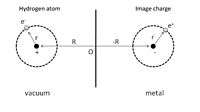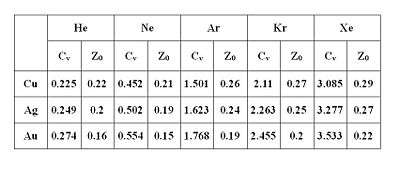Physisorption
Physisorption, also called physical adsorption, is a process in which the electronic structure of the atom or molecule is barely perturbed upon adsorption.[1][2][3]
Introduction
The fundamental interacting force of physisorption is caused by van der Waals force. Even though the interaction energy is very weak (~10–100 meV), physisorption plays an important role in nature. For instance, the van der Waals attraction between surfaces and foot-hairs of geckos provides the remarkable ability to climb up vertical walls.[4] Van der Waals forces originate from the interactions between induced, permanent or transient electric dipoles.
In comparison with chemisorption, in which the electronic structure of bonding atoms or molecules is changed and covalent or ionic bonds form, physisorption, generally speaking, can only be observed in the environment of low temperature (thermal energy at room temperature ~26 meV) and the absence of the relatively strong chemisorptions. In practice, the categorisation of a particular adsorption as physisorption or chemisorption depends principally on the binding energy of the adsorbate to the substrate.
Modeling by image charge

To give a simple illustration of physisorption, we can first consider an adsorbed hydrogen atom in front of a perfect conductor, as shown in Fig. 1. A nucleus with positive charge is located at R = (0, 0, Z), and the position coordinate of its electron, r = (x, y, z) is given with respect to the nucleus. The adsorption process can be viewed as the interaction between this hydrogen atom and its image charges of both the nucleus and electron in the conductor. As a result, the total electrostatic energy is the sum of attraction and repulsion terms:
The first term is the attractive interaction of nucleus and its image charge, and the second term is due to the interaction of the electron and its image charge. The repulsive interaction is shown in the third and fourth terms arising from the interaction of nucleus-image electron and electron-image nucleus, respectively.
By Taylor expansion in powers of |r| / |R|, this interaction energy can be further expressed as:
One can find from the first non-vanishing term that the physisorption potential depends on the distance Z between adsorbed atom and surface as Z−3, in contrast with the r−6 dependence of the molecular van der Waals potential, where r is the distance between two dipoles.
Modeling by quantum-mechanical oscillator
The van der Waals binding energy can be analyzed by another simple physical picture: modeling the motion of an electron around its nucleus by a three-dimensional simple harmonic oscillator with a potential energy Va:
where me and ω are the mass and vibrational frequency of the electron, respectively.
As this atom approaches the surface of a metal and forms adsorption, this potential energy Va will be modified due to the image charges by additional potential terms which are quadratic in the displacements:
- (from the Taylor expansion above.)
Assuming
the potential is well approximated as
- ,
where
If one assumes that the electron is in the ground state, then the van der Waals binding energy is essentially the change of the zero-point energy:
This expression also shows the nature of the Z−3 dependence of the van der Waals interaction.
Furthermore, by introducing the atomic polarizability,
the van der Waals potential can be further simplified:
where
is the van der Waals constant which is related to the atomic polarizability.
Also, by expressing the fourth-order correction in the Taylor expansion above as (aCvZ0) / (Z4), where a is some constant, we can define Z0 as the position of the dynamical image plane and obtain

The origin of Z0 comes from the spilling of the electron wavefunction out of the surface. As a result, the position of image plane representing the reference for the space coordinate is different from the substrate surface itself and modified by Z0.
Table 1 shows the jellium model calculation for van der Waals constant Cv and dynamical image plane Z0 of rare gas atoms on various metal surfaces. The increasing of Cv from He to Xe for all metal substrates is caused by the larger atomic polarizability of the heavier rare gas atoms. For the position of the dynamical image plane, it decreases with increasing dielectric function and is typically on the order of 0.2 Å.
Physisorption potential
Even though the van der Waals interaction is attractive, as the adsorbed atom moves closer to the surface the wavefunction of electron starts to overlap with that of the surface atoms. Further the energy of the system will increase due to the orthogonality of wavefunctions of the approaching atom and surface atoms.
This Pauli exclusion and repulsion are particularly strong for atoms with closed valence shells that dominate the surface interaction. As a result, the minimum energy of physisorption must be found by the balance between the long-range van der Waals attraction and short-range Pauli repulsion. For instance, by separating the total interaction of physisorption into two contributions- a short-range term depicted by Hartree–Fock theory and a long-range van der Waals attraction, the equilibrium position of physisorption for rare gases adsorbed on jellium substrate can be determined.[5] Fig. 2 shows the physisorption potential energy of He adsorbed on Ag, Cu, and Au substrates which are described by the jellium model with different densities of smear-out background positive charges. It can be found that the weak van der Waals interaction leads to shallow attractive energy wells (<10 meV). One of the experimental methods for exploring physisorption potential energy is the scattering process, for instance, inert gas atoms scattered from metal surfaces. Certain specific features of the interaction potential between scattered atoms and surface can be extracted by analyzing the experimentally determined angular distribution and cross sections of the scattered particles.
Comparison with chemisorption
- Physisorption is a general phenomenon and occurs in any solid/fluid or solid/gas system. Chemisorption is characterized by chemical specificity.
- In physisorption, perturbation of the electronic states of adsorbent and adsorbate is minimal. For chemisorption, changes in the electronic states may be detectable by suitable physical means.
- Typical binding energy of physisorption is about 10–100 meV. Chemisorption usually forms bonding with energy of 1–10 eV.
- The elementary step in physisorption from a gas phase does not involve an activation energy. Chemisorption often involves an activation energy.
- For physisorption, under appropriate conditions, gas phase molecules can form multilayer adsorption. In chemisorption, molecules are adsorbed on the surface by valence bonds and only form monolayer adsorption.
See also
References
- ↑ K. Oura; et al. (2003), Surface Science, An Introduction, Berlin: Springer, ISBN 978-3-540-00545-2
- ↑ M. C. Desjonqueres; et al. (1996. Corrected printing 1998), Concepts in surface physics (2nd ed.), New York: Springer-Verlag, ISBN 3-540-58622-9, retrieved 29 August 2012 Check date values in:
|date=(help) - ↑ Hans Luth; et al. (1993), Surfaces and interfaces of solids, Springer-Verlag, ISBN 978-3-540-56840-7
- ↑ K. Autumn; et al. (2000), "Adhesive force of a single gecko foot-hair", Nature, 405 (6787): 681–5, doi:10.1038/35015073, PMID 10864324
- 1 2 E. Zaremba and W. Kohn (1977), "Theory of helium adsorption on simple and noble-metal surfaces", Phys. Rev. B, 15 (4): 1769, Bibcode:1977PhRvB..15.1769Z, doi:10.1103/PhysRevB.15.1769
